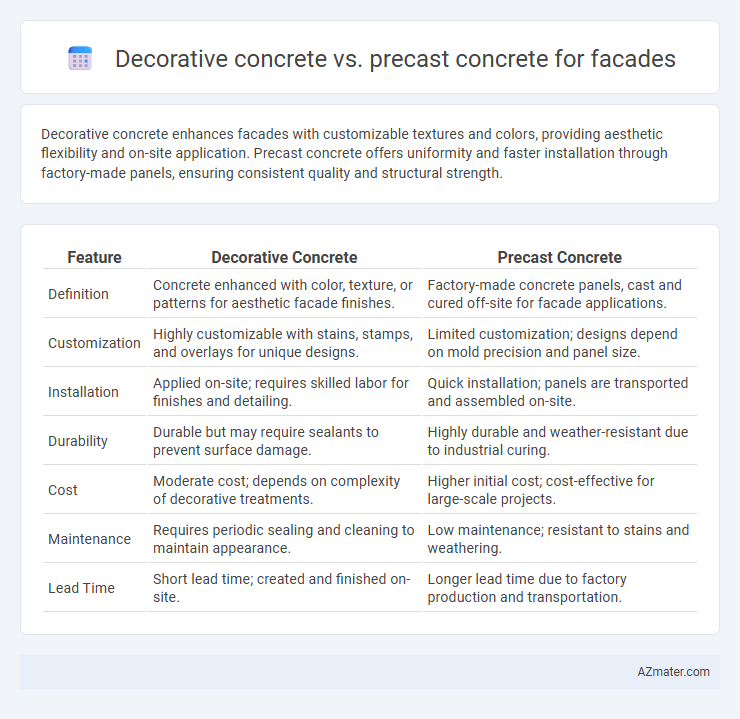Decorative concrete enhances facades with customizable textures and colors, providing aesthetic flexibility and on-site application. Precast concrete offers uniformity and faster installation through factory-made panels, ensuring consistent quality and structural strength.
Table of Comparison
| Feature | Decorative Concrete | Precast Concrete |
|---|---|---|
| Definition | Concrete enhanced with color, texture, or patterns for aesthetic facade finishes. | Factory-made concrete panels, cast and cured off-site for facade applications. |
| Customization | Highly customizable with stains, stamps, and overlays for unique designs. | Limited customization; designs depend on mold precision and panel size. |
| Installation | Applied on-site; requires skilled labor for finishes and detailing. | Quick installation; panels are transported and assembled on-site. |
| Durability | Durable but may require sealants to prevent surface damage. | Highly durable and weather-resistant due to industrial curing. |
| Cost | Moderate cost; depends on complexity of decorative treatments. | Higher initial cost; cost-effective for large-scale projects. |
| Maintenance | Requires periodic sealing and cleaning to maintain appearance. | Low maintenance; resistant to stains and weathering. |
| Lead Time | Short lead time; created and finished on-site. | Longer lead time due to factory production and transportation. |
Introduction to Decorative and Precast Concrete Facades
Decorative concrete facades enhance building aesthetics through customizable textures, colors, and patterns, providing versatility in design without compromising durability. Precast concrete facades are factory-made panels, offering consistent quality, expedited installation, and superior structural performance. Both systems serve functional and architectural purposes, with decorative concrete emphasizing artistic expression and precast concrete prioritizing efficiency and strength.
Key Differences Between Decorative and Precast Concrete
Decorative concrete offers customizable aesthetics with integrally colored finishes, stamped patterns, and textures directly applied on-site, enabling intricate facade designs and unique architectural expressions. Precast concrete is manufactured in controlled factory environments, ensuring consistent quality, high structural strength, and faster installation times, suitable for modular facade components and large-scale projects. While decorative concrete emphasizes surface customization and visual appeal, precast concrete prioritizes uniformity, durability, and efficient assembly for building exteriors.
Aesthetic Versatility: Design Options
Decorative concrete offers extensive aesthetic versatility with customizable textures, colors, and patterns, enabling unique and intricate facade designs that mimic natural materials like stone or wood. Precast concrete provides consistent quality and can incorporate architectural details, but its design options are limited to factory-molded shapes and finishes. Choosing decorative concrete enhances creative flexibility for facades, while precast concrete favors uniformity and speed in construction.
Durability and Structural Performance
Decorative concrete offers customizable aesthetics with moderate durability, suitable for non-load-bearing facade elements, while precast concrete provides superior structural performance and higher durability due to factory-controlled production and reinforced composition. Precast panels resist harsh weather conditions, impact, and environmental stress better, ensuring long-term facade integrity. For applications requiring both visual appeal and robust structural support, combining decorative overlays on precast concrete can optimize facade performance.
Installation Process Comparison
Decorative concrete installation for facades involves on-site casting, allowing customization of textures and colors directly on the building, but it requires skilled labor and longer curing times. Precast concrete panels are manufactured in controlled factory environments, ensuring consistent quality and faster on-site assembly with crane installation, minimizing weather-related delays. The choice impacts project timelines, labor costs, and finish precision, with precast offering expedited installation and decorative concrete providing more design flexibility.
Cost Implications and Budget Considerations
Decorative concrete for facades offers customizable aesthetics at potentially lower initial costs compared to precast concrete, which involves higher upfront expenses due to factory production and transportation. Budget considerations must account for maintenance expenses, with decorative concrete possibly requiring more frequent upkeep, while precast concrete delivers long-term durability and reduced repair costs. Selecting between the two depends on project scale, desired finish quality, and total lifecycle cost analysis.
Maintenance Requirements and Longevity
Decorative concrete facades often require regular sealing and cleaning to maintain their aesthetic appeal and protect against weathering, impacting long-term maintenance costs. Precast concrete panels offer enhanced durability with minimal upkeep due to factory-controlled manufacturing processes that ensure consistent quality and resistance to cracking. Longevity of precast concrete typically surpasses decorative concrete, as it withstands environmental stress better and reduces the need for frequent repairs or resurfacing.
Environmental Impact and Sustainability
Decorative concrete for facades often incorporates recycled materials and reduces waste through on-site pouring, enhancing its sustainability profile compared to precast concrete, which involves industrial manufacturing and transportation emissions. Precast concrete, while energy-intensive to produce, offers durability and potential for reuse or recycling at the end of its lifecycle, contributing to a circular economy in construction. Choosing between decorative and precast concrete depends on project-specific environmental goals, local material sourcing, and long-term sustainability strategies.
Best Applications for Decorative Concrete Facades
Decorative concrete facades excel in applications requiring customized textures, intricate patterns, and vibrant color options, making them ideal for architectural projects focused on aesthetic appeal and design flexibility. These facades are best suited for residential buildings, commercial storefronts, and cultural landmarks where unique visual character and artistic expression are prioritized. Unlike precast concrete, decorative concrete allows onsite sculpting and finishing, offering greater adaptability for complex shapes and seamless integration with surrounding materials.
Ideal Uses for Precast Concrete Facades
Precast concrete facades are ideal for large-scale commercial and institutional buildings where durability and uniformity are critical, offering excellent resistance to weather and fire. They provide efficient installation with precise quality control, making them suitable for repetitive designs and modular construction. Unlike decorative concrete, precast panels support structural loads and enable faster project timelines through off-site manufacturing.

Infographic: Decorative concrete vs Precast concrete for Facade
 azmater.com
azmater.com